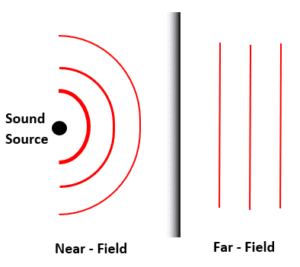In the far-field model, sound propagates as a plane wave and the phase shifts across a microphone array are only dependent on the angle or arrival and the geometry of the array. The far-field sound propagation model is preferred over the near-field model because it makes finding analytical solutions for optimal beamformers realizable. This model is practical to use in many speech enhancement applications because the desired speech source is often greater than a 1 meter from the array, which can be 10x greater than the size of the array.
While this sound propagation model may hold in practice, the microphone channels may not be perfectly matched. Manufacturing tolerances of the microphones, ADCs, and preamplifiers create variability among the array channels, that can cause a mismatch between expected phase shifts and observed phase shifts for a given direction of arrival In addition, final product designs enclose microphone arrays in a mechanical housing, which may not be acoustically transparent. This channel mismatch will have a negative impact on the white noise gain (WNG) and the directivity index (DI) of the beamformer.
In order to minimize the phase mismatch a calibration procedure is required. Calibration methods can be performed at the factory or during an installation, but a real-time calibration solution is preferred. One solution is to observe the phase difference between a selected reference microphone and the other microphones after they have been align based on the desired steering vector. Based on the long-term average of the phase differences when the desired signal has been determined to be present, a phase adjustment can be applied to each microphone signal prior to summation for beamforming. Since the channel mismatch can be frequency dependent, this calibration should be performed and applied independently in the frequency domain.
VOCAL Technologies offers custom designed solutions for beamforming with a robust voice activity detector, acoustic echo cancellation and noise suppression. Our custom implementations of such systems are meant to deliver optimum performance for your specific beamforming task.
